| Authors: | Ángeles G. Mayor, V Ramón Vallejo, Susana Bautista with Peter de Ruiter, Lia Hemerik, Violette Geissen, Jaap Bloem, Jacob Kéizer, Óscar González-Pelayo, Ana Isabel Machado, Ana Vasques, Christel van Eck, Martinho Martins, Paula Maia, Alejandro Valdecantos, Jaime Baeza, Joan Llovet and David Fuentes |
| Editor: | Jane Brandt |
| Source document: | Mayor et al. (2015) Identification of critical changes preceding catastrophic shifts: ecosystems affeced by increasing wildfire recurrence. CASCADE Project Deliverable 3.1a |
Short-term effects of fire recurrence on soil nutrients
In general, the fertility of the top mineral soil (0-5 cm) one year after fire was more influenced by the occurrence of the last fire than by the number of previous fires (1 or 4 fires in the last 37 years). Still, there was a decreasing trend with increasing fire recurrence in soil organic C and total N, as well as with their labile fractions, although this latter trend was not significant (Figure 2)
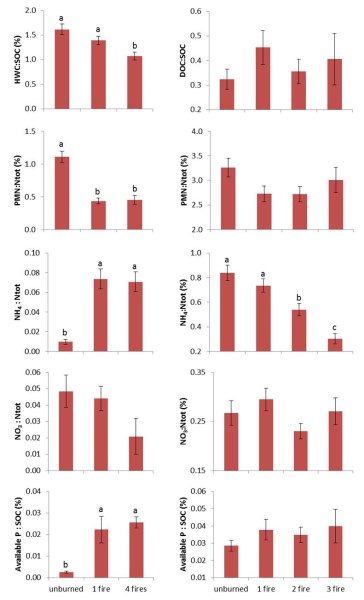
Figure 1 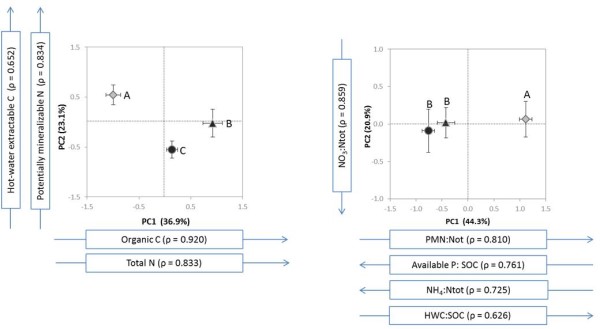
Figure 2
Thus, the occurrence of the last fire had a positive effect on soil organic C, total N, NH4, and available P, which were higher in burned than in unburned soils eight months after the occurrence of one or even four fires. The short-term post-fire pulse in NH4 and available P is commonly found in the literature and is associated with NH4 addition with ash deposition and soil heating, and with the pyro-mineralization of organic P during the fire, respectively (Serrasolsas and Khanna 1995, Certini 2005). Short-term (< 5 years) increases in soil organic matter following fire have also been reported in other woodland ecosystems in southern Europe (Rashid 1987, Dumontet et al 1996, Perez et al 2004, Knicker et al 2005) and are commonly attributed to the decomposition of partially burned woody fragments and charcoal formation (Almendros et al. 1990, Knicker et al 2006, Certini et al. 2011). However, the higher values of N in burned than in unburned soils does not support the idea of relevant quantities of fire-deposited charcoal as this component has a very low content in N. Despite the positive impact of fire occurrence on the total amount of soil nitrogen, its potentially mineralizable fraction did not increase resulting in a lower potentially mineralizable N to total N ratio in burned than in unburned soils (Figure 1 and 2). Thus, fire increased the quantity of soil organic matter but decreased its quality, and to a similar degree for both soils burned once or four times (Figure 2).
The fire-induced increase in soil organic C and total N, mainly represented by the first component performed with the quantity matrix, was mitigated by fire frequency as this component was lower in soils burned four times than in soils only burned once. These results may be attributed to a lower woody biomass before the 2012 fire in plots burned with higher fire frequency, relative to plots burned only once, and thus a lower increase in soil organic matter due to root death.
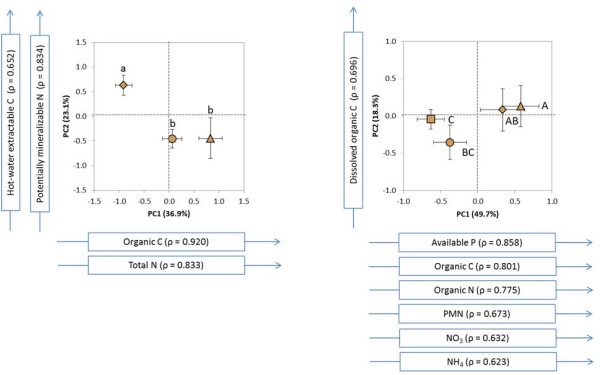
Figure 3
The fertility of the soils in the microsites assessed, shrub patches of P. tridentatum and interspaces in between these shrubs, generally showed the same short-term response to fire. The intershrub microsite was however more sensitive to the occurrence of fire, as it showed significant higher soil organic C and total N in burned than in unburned soils, but also significant lower values for C and N labile fractions in burned than in unburned soils (Figure 3).
Long-term effects of fire recurrence on soil nutrients
Soil organic C and most nutrients of the top mineral soil (0-5 cm) in Valencia showed higher values in long unburned soils (at least for 30 years) than in soils burned two or three times (20 and 8 years after the last fire, respectively). This trend was however not significant due to the large variation in the response of the blocks analysed (Figure 4). Although two of the blocks, Alcoy and Ayora showed decreasing trends in soil fertility with increasing fire recurrence (1, 2, or 3 fires), the third block, Onil, only showed this trend for dissolved organic C.
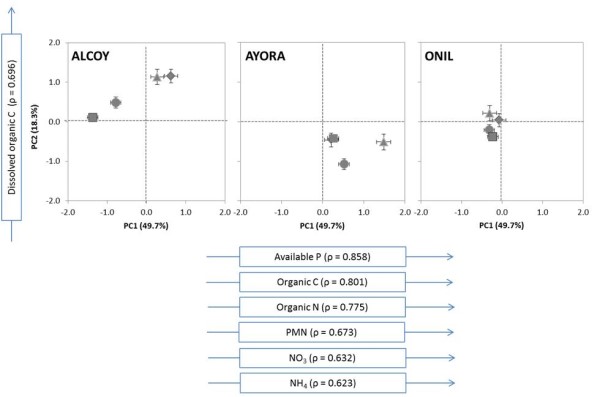
Figure 4
In agreement with our results, most related studies in Mediterranean Europe measuring the long-term response following fire (> 5 years) found that shrublands or woodlands burned with high fire recurrence, that is three or four times in a period of up to 57 years, had significantly lower soil organic matter than sites only affected by one or no wildfire during that period (Carreira et al. 1994, Guénon et al. 2011, Tessler et al. 2013). A negative effect of fire recurrence in the quantity of mineral soil organic matter is associated with the cumulative effects of recurrent fires in reducing soil organic horizons (Eugenio et al. 2006). In our study site, long-term changes in soil organic C and nutrients related to fire impact on vegetation are also possibly related to changes in the composition of vegetation along post-fire succession since: unburned and 1-fire were pine forests, whereas 2- and 3-fires plots were shrublands. Litterfall quantity and quality, and decomposition rate, may be different for both groups of plots.
Long-term post-fire reductions in soil C may limit microbial activity and constrain gross production of NH4 over time (Koyama et al 2010) as we observed in our study area (Figure 5). Furthermore, nitrogen availability may decline over secondary succession as plant and microbial competition for N increases and regenerating vegetation alters the soil microclimate. On the other hand, significant amounts of N can be volatilised or lost due to erosion. Thus, despite temporary post-fire enhanced mineral organic C and N availability, repeated burning in Mediterranean steep areas may lead to substantial depletion of the total N reserves, causing marked changes in the long-term pattern of N cycling (Carreira et al 1995, 1996).
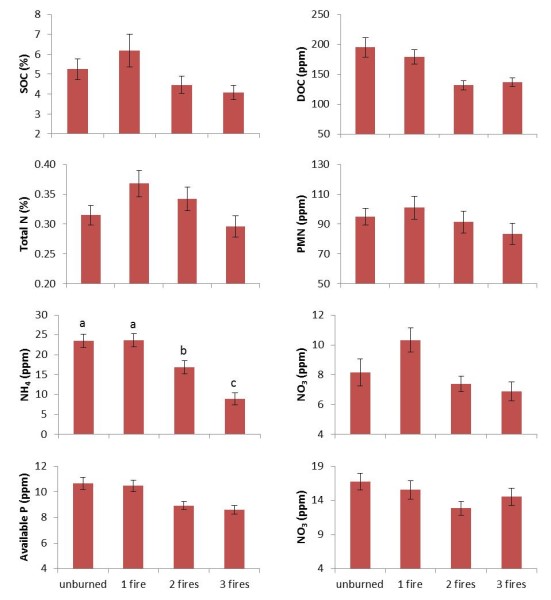
Figure 5
As happened in the Várzea study site, the surface of the intershrubs in Valencia seemed to be more sensitive to fire impact than that of the shrub patches analysed in this site (Q. coccifera and R. officinalis), as intershrub microsites did show a significant decrease of soil organic matter with increasing fire recurrence (Figure 3).
Indicators of changes in soil functioning in response to fire recurrence
Our results suggested a higher sensitivity of the soil surface between shrubs, relative to the surface below shrub patches, to the fire occurrence and recurrence. We attributed this result to differences between the two microsites in the recovery rate after fire. The canopies of shrub patches recover fast after the fire (e.g., Malanson and Trabaud, 1987; Pausas et al., 1999). This entails a higher accumulation of organic matter content in shrub patches, particularly for resprouter shrubs as supported by their higher soil organic C in both of ours study sites. The accumulation of organic matter in shrub patches is not only due to plant litter from the same patch but also through its sink role by trapping soil, seeds and litter from upslope areas during the first post-fire rainstorms (Cammeraat and Imeson, 1999; unpublished observations). Contrastingly, the openings between shrubs, either partially bare or covered by short herbaceous species, have a lower capacity to trap resources and function more like source areas.
Soil organic C and total N gave a similar response to fire recurrence at both the short- and long-term following fire, that is, a decreasing trend with increasing fire recurrence (1, 2, 3 or 4 fires in 37 years). However, the comparison with reference areas at the short term may give biased information due to the transient fire-induced pulse of soil fertility. Thus, relative to long unburned areas, a single fire may increase the quantity of soil organic matter in areas burnt with low or even high fire recurrence the first years following the fire. It, however, may still not increase the bioavailability of soil C and nutrients. In this regard, labile fractions of soil organic matter may be more robust indicators of changes in soil functioning in response to fire recurrence.
Our results also suggest a shift in mineral soil fertility associated with a fire-induced shift of pine woodlands to shrublands. Drops in soil fertility quantity and quality were generally higher between areas burned once and twice, corresponding with the replacement of woodlands by shrublands, than between areas burned twice and thrice, both of them shrublands (Figure 6).
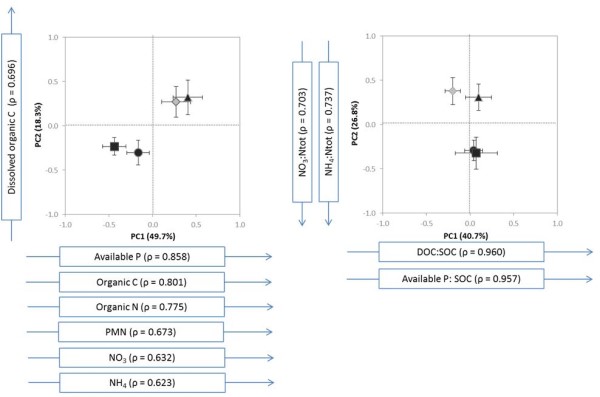
Figure 6
The detailed results from the two fire-affected sites can be found here
» Várzea Portugal: Critical changes preceding a catastrophic shift
» Ayora, Spain: Critical changes preceding a catastrophic shift
Note: For full references to papers quoted in this article see
